Guangliang Cheng
RAIDX: A Retrieval-Augmented Generation and GRPO Reinforcement Learning Framework for Explainable Deepfake Detection
Aug 06, 2025Abstract:The rapid advancement of AI-generation models has enabled the creation of hyperrealistic imagery, posing ethical risks through widespread misinformation. Current deepfake detection methods, categorized as face specific detectors or general AI-generated detectors, lack transparency by framing detection as a classification task without explaining decisions. While several LLM-based approaches offer explainability, they suffer from coarse-grained analyses and dependency on labor-intensive annotations. This paper introduces RAIDX (Retrieval-Augmented Image Deepfake Detection and Explainability), a novel deepfake detection framework integrating Retrieval-Augmented Generation (RAG) and Group Relative Policy Optimization (GRPO) to enhance detection accuracy and decision explainability. Specifically, RAIDX leverages RAG to incorporate external knowledge for improved detection accuracy and employs GRPO to autonomously generate fine-grained textual explanations and saliency maps, eliminating the need for extensive manual annotations. Experiments on multiple benchmarks demonstrate RAIDX's effectiveness in identifying real or fake, and providing interpretable rationales in both textual descriptions and saliency maps, achieving state-of-the-art detection performance while advancing transparency in deepfake identification. RAIDX represents the first unified framework to synergize RAG and GRPO, addressing critical gaps in accuracy and explainability. Our code and models will be publicly available.
So-Fake: Benchmarking and Explaining Social Media Image Forgery Detection
May 24, 2025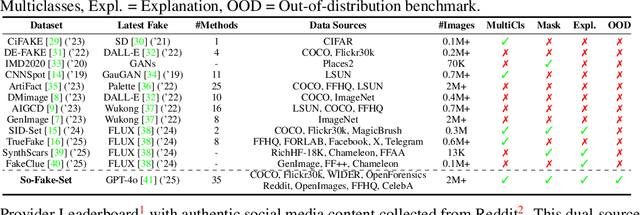
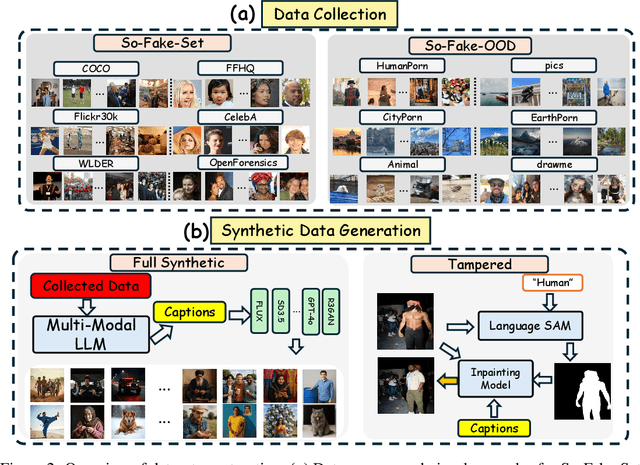
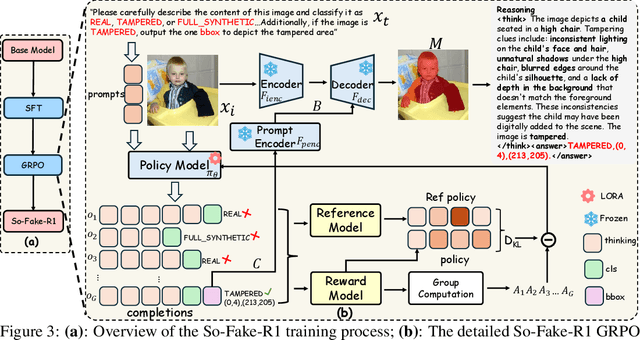
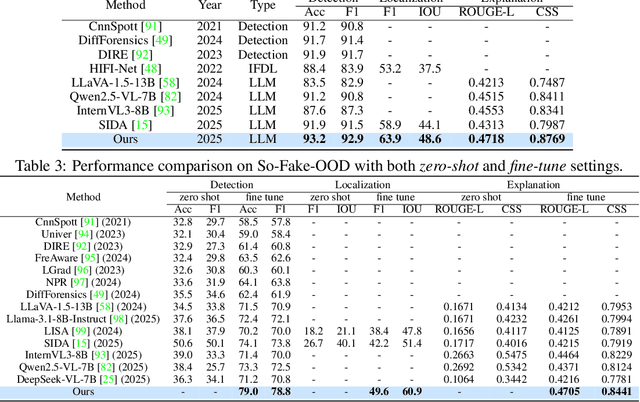
Abstract:Recent advances in AI-powered generative models have enabled the creation of increasingly realistic synthetic images, posing significant risks to information integrity and public trust on social media platforms. While robust detection frameworks and diverse, large-scale datasets are essential to mitigate these risks, existing academic efforts remain limited in scope: current datasets lack the diversity, scale, and realism required for social media contexts, while detection methods struggle with generalization to unseen generative technologies. To bridge this gap, we introduce So-Fake-Set, a comprehensive social media-oriented dataset with over 2 million high-quality images, diverse generative sources, and photorealistic imagery synthesized using 35 state-of-the-art generative models. To rigorously evaluate cross-domain robustness, we establish a novel and large-scale (100K) out-of-domain benchmark (So-Fake-OOD) featuring synthetic imagery from commercial models explicitly excluded from the training distribution, creating a realistic testbed for evaluating real-world performance. Leveraging these resources, we present So-Fake-R1, an advanced vision-language framework that employs reinforcement learning for highly accurate forgery detection, precise localization, and explainable inference through interpretable visual rationales. Extensive experiments show that So-Fake-R1 outperforms the second-best method, with a 1.3% gain in detection accuracy and a 4.5% increase in localization IoU. By integrating a scalable dataset, a challenging OOD benchmark, and an advanced detection framework, this work establishes a new foundation for social media-centric forgery detection research. The code, models, and datasets will be released publicly.
BusterX: MLLM-Powered AI-Generated Video Forgery Detection and Explanation
May 19, 2025
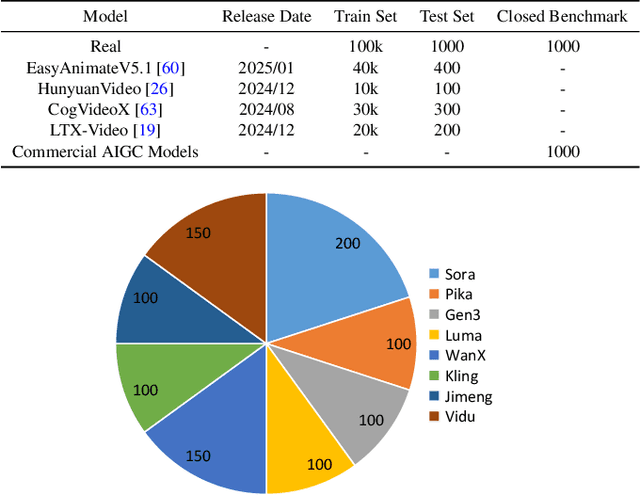
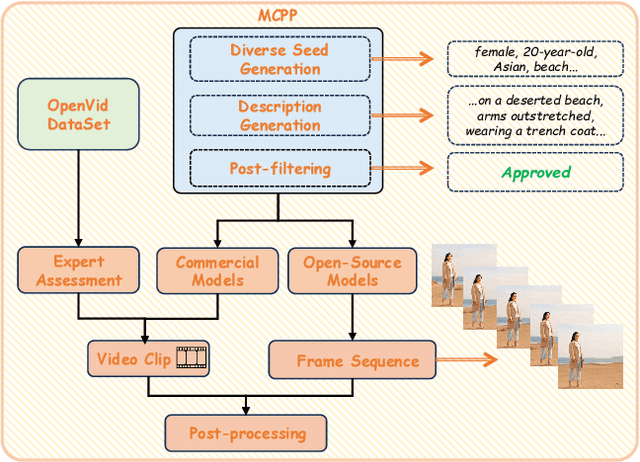
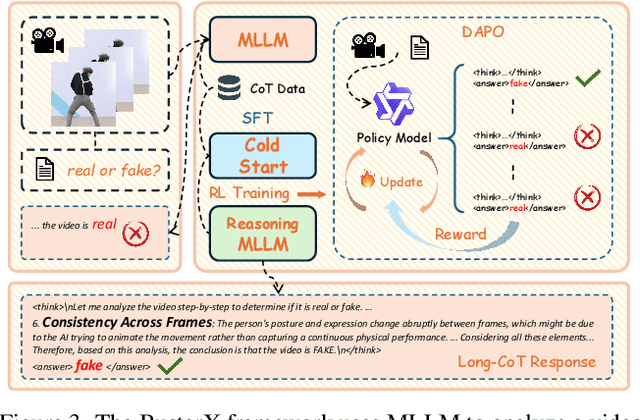
Abstract:Advances in AI generative models facilitate super-realistic video synthesis, amplifying misinformation risks via social media and eroding trust in digital content. Several research works have explored new deepfake detection methods on AI-generated images to alleviate these risks. However, with the fast development of video generation models, such as Sora and WanX, there is currently a lack of large-scale, high-quality AI-generated video datasets for forgery detection. In addition, existing detection approaches predominantly treat the task as binary classification, lacking explainability in model decision-making and failing to provide actionable insights or guidance for the public. To address these challenges, we propose \textbf{GenBuster-200K}, a large-scale AI-generated video dataset featuring 200K high-resolution video clips, diverse latest generative techniques, and real-world scenes. We further introduce \textbf{BusterX}, a novel AI-generated video detection and explanation framework leveraging multimodal large language model (MLLM) and reinforcement learning for authenticity determination and explainable rationale. To our knowledge, GenBuster-200K is the {\it \textbf{first}} large-scale, high-quality AI-generated video dataset that incorporates the latest generative techniques for real-world scenarios. BusterX is the {\it \textbf{first}} framework to integrate MLLM with reinforcement learning for explainable AI-generated video detection. Extensive comparisons with state-of-the-art methods and ablation studies validate the effectiveness and generalizability of BusterX. The code, models, and datasets will be released.
Vision Mamba in Remote Sensing: A Comprehensive Survey of Techniques, Applications and Outlook
May 01, 2025Abstract:Deep learning has profoundly transformed remote sensing, yet prevailing architectures like Convolutional Neural Networks (CNNs) and Vision Transformers (ViTs) remain constrained by critical trade-offs: CNNs suffer from limited receptive fields, while ViTs grapple with quadratic computational complexity, hindering their scalability for high-resolution remote sensing data. State Space Models (SSMs), particularly the recently proposed Mamba architecture, have emerged as a paradigm-shifting solution, combining linear computational scaling with global context modeling. This survey presents a comprehensive review of Mamba-based methodologies in remote sensing, systematically analyzing about 120 studies to construct a holistic taxonomy of innovations and applications. Our contributions are structured across five dimensions: (i) foundational principles of vision Mamba architectures, (ii) micro-architectural advancements such as adaptive scan strategies and hybrid SSM formulations, (iii) macro-architectural integrations, including CNN-Transformer-Mamba hybrids and frequency-domain adaptations, (iv) rigorous benchmarking against state-of-the-art methods in multiple application tasks, such as object detection, semantic segmentation, change detection, etc. and (v) critical analysis of unresolved challenges with actionable future directions. By bridging the gap between SSM theory and remote sensing practice, this survey establishes Mamba as a transformative framework for remote sensing analysis. To our knowledge, this paper is the first systematic review of Mamba architectures in remote sensing. Our work provides a structured foundation for advancing research in remote sensing systems through SSM-based methods. We curate an open-source repository (https://github.com/BaoBao0926/Awesome-Mamba-in-Remote-Sensing) to foster community-driven advancements.
ASP-VMUNet: Atrous Shifted Parallel Vision Mamba U-Net for Skin Lesion Segmentation
Mar 25, 2025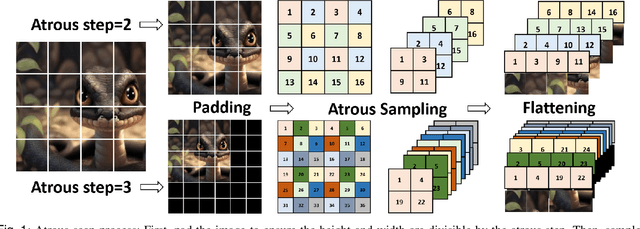
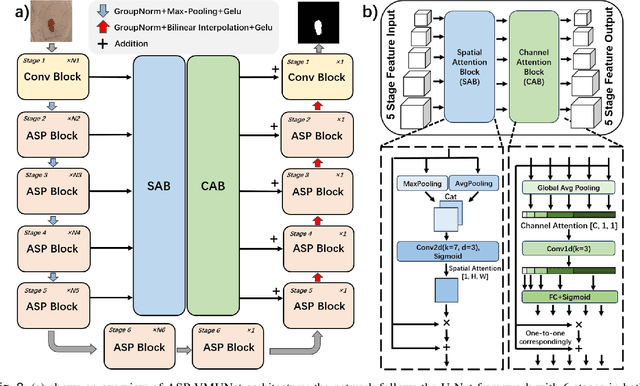
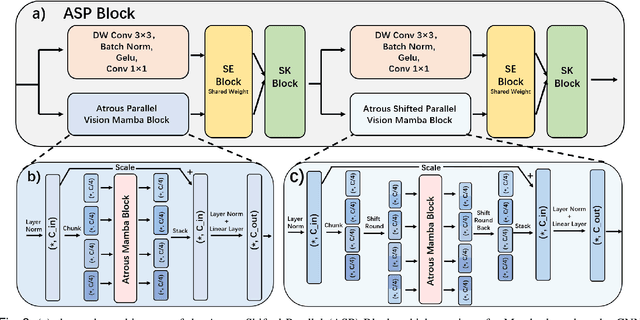
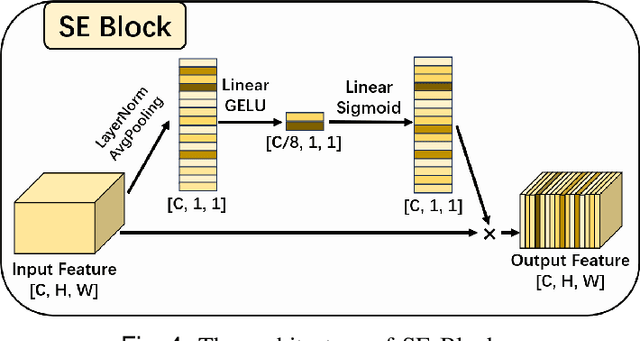
Abstract:Skin lesion segmentation is a critical challenge in computer vision, and it is essential to separate pathological features from healthy skin for diagnostics accurately. Traditional Convolutional Neural Networks (CNNs) are limited by narrow receptive fields, and Transformers face significant computational burdens. This paper presents a novel skin lesion segmentation framework, the Atrous Shifted Parallel Vision Mamba UNet (ASP-VMUNet), which integrates the efficient and scalable Mamba architecture to overcome limitations in traditional CNNs and computationally demanding Transformers. The framework introduces an atrous scan technique that minimizes background interference and expands the receptive field, enhancing Mamba's scanning capabilities. Additionally, the inclusion of a Parallel Vision Mamba (PVM) layer and a shift round operation optimizes feature segmentation and fosters rich inter-segment information exchange. A supplementary CNN branch with a Selective-Kernel (SK) Block further refines the segmentation by blending local and global contextual information. Tested on four benchmark datasets (ISIC16/17/18 and PH2), ASP-VMUNet demonstrates superior performance in skin lesion segmentation, validated by comprehensive ablation studies. This approach not only advances medical image segmentation but also highlights the benefits of hybrid architectures in medical imaging technology. Our code is available at https://github.com/BaoBao0926/ASP-VMUNet/tree/main.
Unlock Pose Diversity: Accurate and Efficient Implicit Keypoint-based Spatiotemporal Diffusion for Audio-driven Talking Portrait
Mar 17, 2025Abstract:Audio-driven single-image talking portrait generation plays a crucial role in virtual reality, digital human creation, and filmmaking. Existing approaches are generally categorized into keypoint-based and image-based methods. Keypoint-based methods effectively preserve character identity but struggle to capture fine facial details due to the fixed points limitation of the 3D Morphable Model. Moreover, traditional generative networks face challenges in establishing causality between audio and keypoints on limited datasets, resulting in low pose diversity. In contrast, image-based approaches produce high-quality portraits with diverse details using the diffusion network but incur identity distortion and expensive computational costs. In this work, we propose KDTalker, the first framework to combine unsupervised implicit 3D keypoint with a spatiotemporal diffusion model. Leveraging unsupervised implicit 3D keypoints, KDTalker adapts facial information densities, allowing the diffusion process to model diverse head poses and capture fine facial details flexibly. The custom-designed spatiotemporal attention mechanism ensures accurate lip synchronization, producing temporally consistent, high-quality animations while enhancing computational efficiency. Experimental results demonstrate that KDTalker achieves state-of-the-art performance regarding lip synchronization accuracy, head pose diversity, and execution efficiency.Our codes are available at https://github.com/chaolongy/KDTalker.
BFANet: Revisiting 3D Semantic Segmentation with Boundary Feature Analysis
Mar 16, 2025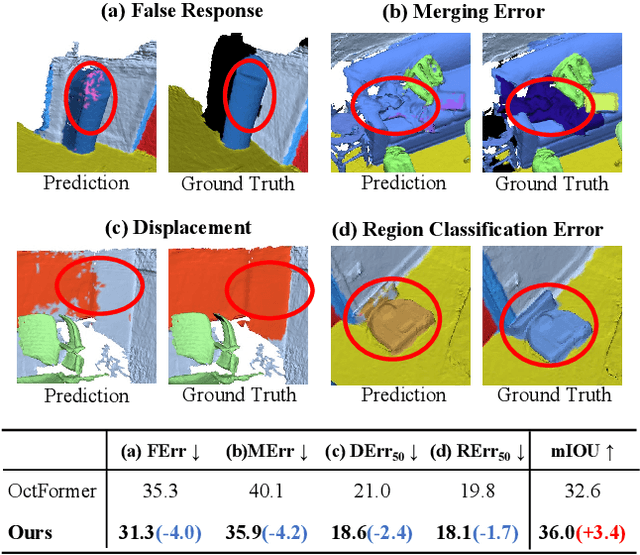

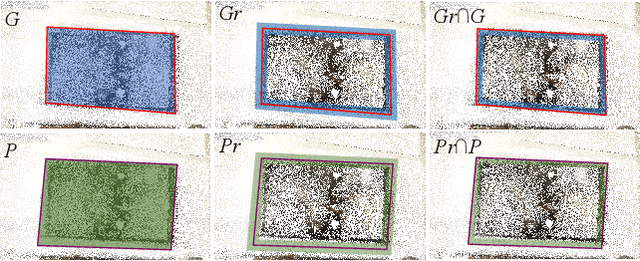
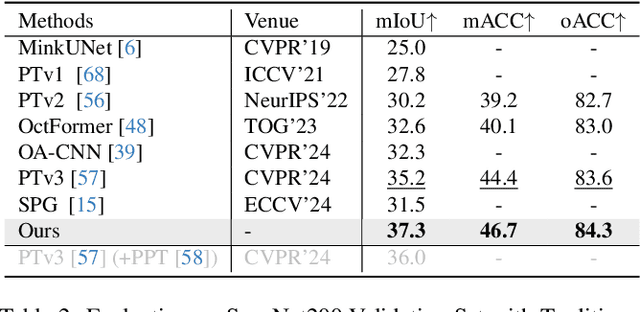
Abstract:3D semantic segmentation plays a fundamental and crucial role to understand 3D scenes. While contemporary state-of-the-art techniques predominantly concentrate on elevating the overall performance of 3D semantic segmentation based on general metrics (e.g. mIoU, mAcc, and oAcc), they unfortunately leave the exploration of challenging regions for segmentation mostly neglected. In this paper, we revisit 3D semantic segmentation through a more granular lens, shedding light on subtle complexities that are typically overshadowed by broader performance metrics. Concretely, we have delineated 3D semantic segmentation errors into four comprehensive categories as well as corresponding evaluation metrics tailored to each. Building upon this categorical framework, we introduce an innovative 3D semantic segmentation network called BFANet that incorporates detailed analysis of semantic boundary features. First, we design the boundary-semantic module to decouple point cloud features into semantic and boundary features, and fuse their query queue to enhance semantic features with attention. Second, we introduce a more concise and accelerated boundary pseudo-label calculation algorithm, which is 3.9 times faster than the state-of-the-art, offering compatibility with data augmentation and enabling efficient computation in training. Extensive experiments on benchmark data indicate the superiority of our BFANet model, confirming the significance of emphasizing the four uniquely designed metrics. Code is available at https://github.com/weiguangzhao/BFANet.
Preference Alignment on Diffusion Model: A Comprehensive Survey for Image Generation and Editing
Feb 10, 2025


Abstract:The integration of preference alignment with diffusion models (DMs) has emerged as a transformative approach to enhance image generation and editing capabilities. Although integrating diffusion models with preference alignment strategies poses significant challenges for novices at this intersection, comprehensive and systematic reviews of this subject are still notably lacking. To bridge this gap, this paper extensively surveys preference alignment with diffusion models in image generation and editing. First, we systematically review cutting-edge optimization techniques such as reinforcement learning with human feedback (RLHF), direct preference optimization (DPO), and others, highlighting their pivotal role in aligning preferences with DMs. Then, we thoroughly explore the applications of aligning preferences with DMs in autonomous driving, medical imaging, robotics, and more. Finally, we comprehensively discuss the challenges of preference alignment with DMs. To our knowledge, this is the first survey centered on preference alignment with DMs, providing insights to drive future innovation in this dynamic area.
FALCON: Fine-grained Activation Manipulation by Contrastive Orthogonal Unalignment for Large Language Model
Feb 03, 2025Abstract:Large language models have been widely applied, but can inadvertently encode sensitive or harmful information, raising significant safety concerns. Machine unlearning has emerged to alleviate this concern; however, existing training-time unlearning approaches, relying on coarse-grained loss combinations, have limitations in precisely separating knowledge and balancing removal effectiveness with model utility. In contrast, we propose Fine-grained Activation manipuLation by Contrastive Orthogonal uNalignment (FALCON), a novel representation-guided unlearning approach that leverages information-theoretic guidance for efficient parameter selection, employs contrastive mechanisms to enhance representation separation, and projects conflict gradients onto orthogonal subspaces to resolve conflicts between forgetting and retention objectives. Extensive experiments demonstrate that FALCON achieves superior unlearning effectiveness while maintaining model utility, exhibiting robust resistance against knowledge recovery attempts.
Position: Towards a Responsible LLM-empowered Multi-Agent Systems
Feb 03, 2025



Abstract:The rise of Agent AI and Large Language Model-powered Multi-Agent Systems (LLM-MAS) has underscored the need for responsible and dependable system operation. Tools like LangChain and Retrieval-Augmented Generation have expanded LLM capabilities, enabling deeper integration into MAS through enhanced knowledge retrieval and reasoning. However, these advancements introduce critical challenges: LLM agents exhibit inherent unpredictability, and uncertainties in their outputs can compound across interactions, threatening system stability. To address these risks, a human-centered design approach with active dynamic moderation is essential. Such an approach enhances traditional passive oversight by facilitating coherent inter-agent communication and effective system governance, allowing MAS to achieve desired outcomes more efficiently.
 Add to Chrome
Add to Chrome Add to Firefox
Add to Firefox Add to Edge
Add to Edge